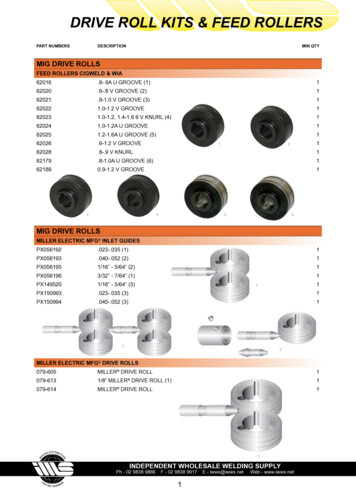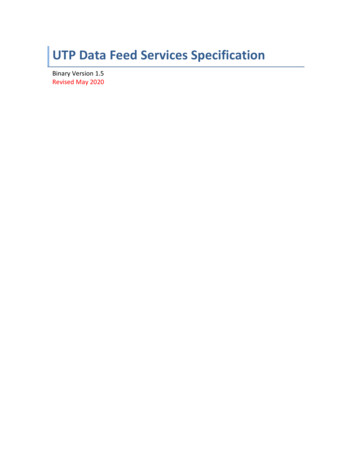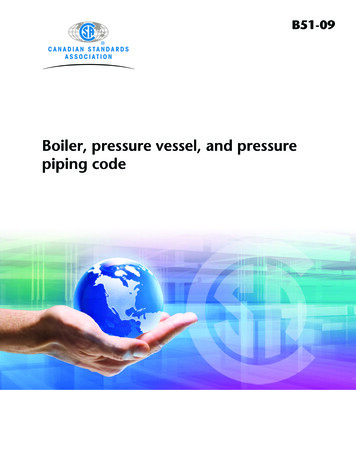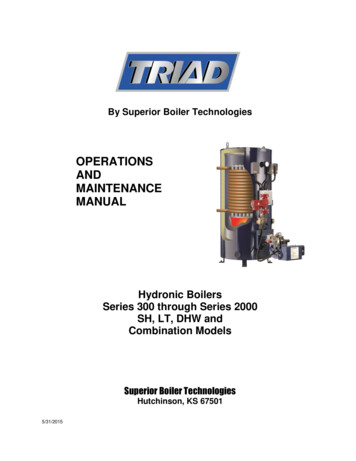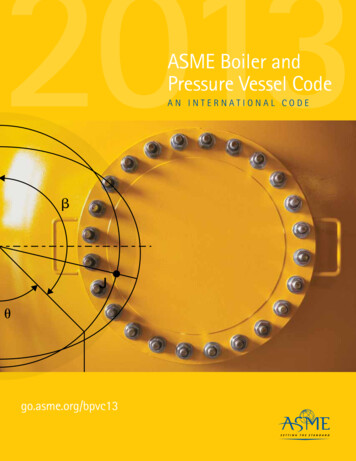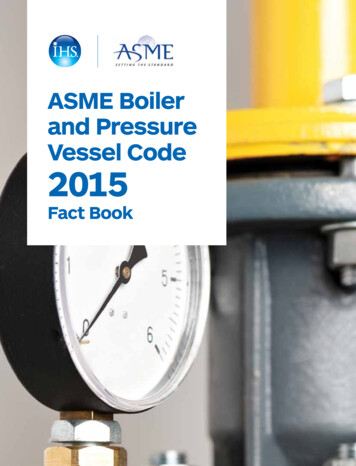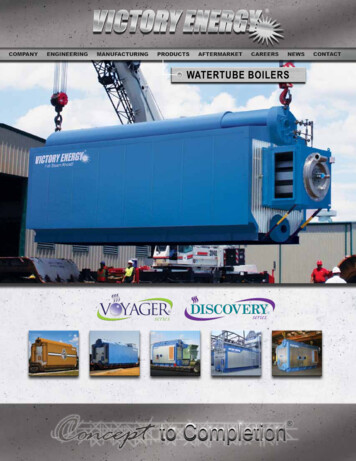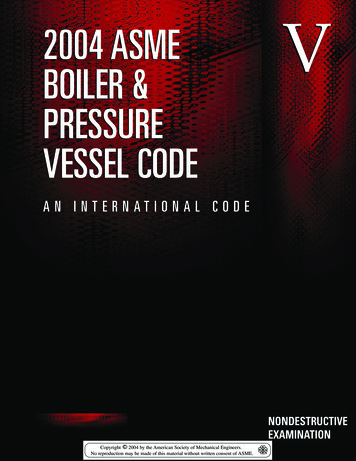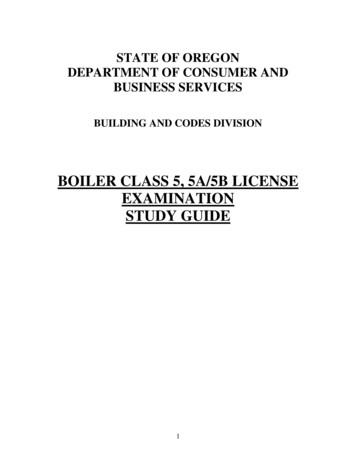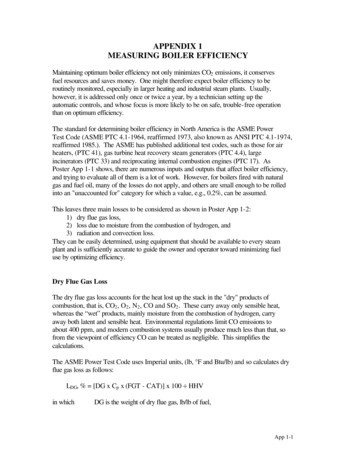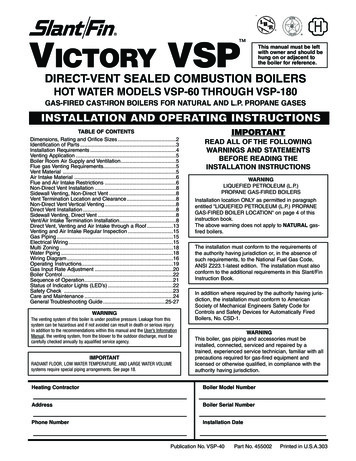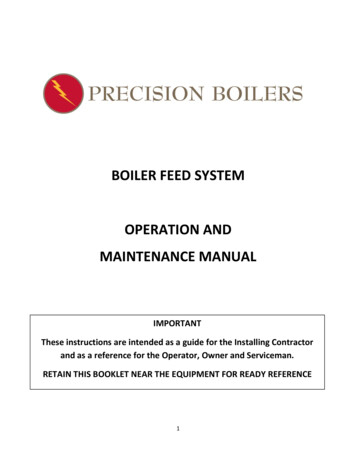
Transcription
BOILER FEED SYSTEMOPERATION ANDMAINTENANCE MANUALIMPORTANTThese instructions are intended as a guide for the Installing Contractorand as a reference for the Operator, Owner and Serviceman.RETAIN THIS BOOKLET NEAR THE EQUIPMENT FOR READY REFERENCE1
TABLE OF CONTENTSI.INSTALLATIONA. UncratingB. PlacementC. Piping ConnectionsD. Electrical ConnectionsE. Flushing and Filling the SystemII.PRE-START INSPECTIONA. Mechanical SystemB. Electrical SystemC. Pump(s)III.STARTUP INSTRUCTIONSA. StartupB. Sparge System (Where installed)IV.MAINTENANCEA. GeneralB. PumpC. Float Level ControlD. Sparge System (Where Installed)V.TROUBLESHOOTINGA. Failure to PumpB. Inadequate Capacity or PressureC. Pump Loses Prime After StartingD. Excessive Power ConsumptionE. Pump Vibrates or is NoisyF. Seal leakageG. Receiver Tank Overflows2
I.INSTALLATIONA. UNCRATINGIMPORTANT: The Boiler Feed System was carefully packed for shipment and left thePrecision Factory complete and in perfect condition. Refer all damages promptly tocarrier. Precision is not responsible for shipping damage or shortages.1. Care must be taken not to damage the unit during uncrating.2. When using pry bars or forklifts, support the Feed System weight on itschannel base only.3. Storage: Electrical equipment can be damaged if exposed to adverseweather. The Feed System must be stored inside. The electrical panel andcontrols must be covered in plastic throughout all construction to avoidaccumulation of dust and moisture.B. PLACEMENT1. Installation must comply with all Federal, State and local codes.2. Locate unit to provide easy access for inspection and maintenance.3. Provide a firm, level foundation for the feed system, preferably a raised,concrete “housekeeping” pad.4. Leave a permanent access space of 30 inches opposite the float level control,the sparge tube/temperature control valve (where applicable) and thepump(s) location. Leave a 36-inch access space opposite the control panel.5. Once the feed system is in place, level it using shims as required and securewith foundation bolts. If desired, the unit may be grouted in place.6. Under no circumstances should anyone climb on the feed system. Climbingmay result in damage to the unit or may result in a fall, resulting in seriousinjury or even death.C. PIPING CONNECTIONS1. Boiler piping connections and valves MUST comply with State and local codesand, where required, ANSI and ASME Boiler and Pressure Vessel Code pipingrequirements.2. Pipe the vent connection full size to outdoors. Make provisions to prevententry of rain and/or snow.3
3. Pipe the feedwater supply line to the boiler. Be sure to include a manualisolation valve and check valve in this line. The check valve should be closestto the feedpump.4. Pipe the make-up water supply line to the the float-feeder connection. Besure to include a manual isolation valve in this line and verify that the linepressure does not exceed the allowable shutoff pressure of the make-upvalve.5. (On units with steam sparge preheater) Plumb the steam line to the steamtemperature control valve. Be sure to include a manual isolation valve in thisline.6. Pipe the overflow line to a safe drain.7. Pipe the system condensate return line to the marked connection on thetank.8. Pipe the drain line from the drain valve mounted on the unit to a safe drain.D. ELECTRICAL CONNECTIONS1. Power Feed Wiring – Recommended wire sizes are listed on the Feed SystemParts List. The full load amperage is listed on both the Parts List and theNameplate. Feed wires must be rated for voltage and full load amperage asspecified in the current edition of the National Electrical Code.2. Equipment Grounding Conductors – The Feed System is equipped withground lug(s) inside the control panel. Grounding conductor(s), properlysized in accordance with the current edition of the National Electrical Code,must be installed.E. FLUSHING AND FILLING THE SYSTEM1. The Feed System and associated piping must be thoroughly flushed beforethe final fill.2. Consult a local water treatment company for recommendations on properflushing procedures and ongoing water treatment. The extent to which theFeed System needs cleaning before operation depends upon the nature ofthe process using the steam.3. Before filling the unit, remove and examine each pump inlet strainer and anyother strainers installed on the feed system. Clean strainers and replace.4. Fill the unit with water using the automatic water level control. Once thelevel control reaches its close-off point, verify the level in the water levelgauge glass. Adjust float height if necessary (see Item IV.C below).4
II.PRE-STARTUP INSPECTIONA. MECHANICAL SYSTEM1. Are all plumbing connections complete and correct?2. Have piping leak tests been completed and necessary repairs finished?B. ELECTRICAL SYSTEM1. With all power turned off; inspect all internal and external electricalcomponents to assure that there has been no damage during shipment orinstallation. Check tightness of all wire connections.2. Are correctly sized fuses, circuit breakers and/or thermal overloads properlyinstalled?C. PUMP(S)1. With power turned off, rotate each pump by hand to insure that pump andmotor are not bound up.2. On each coupled pump, check alignment of coupling between pump andmotor in accordance with pump manufacturer’s instructions.3. Run each motor momentarily to be sure pump rotation matches arrow onpump casing.Caution: Do not run pump dry, as damage will occur to seal and internals.III.START-UP INSTRUCTIONSA. STARTUP1. Open all valves on suction, discharge and makeup water lines.2. Verify that the receiver contains water and that the float level control isoperating properly.3. For vertical pumps with seal bleed connection, verify that bleed line manualvalve is open.4. If bypass/recirculation lines are provided, make sure any stop valves in thoselines are open.5. Switch “HAND-OFF-AUTO” switch to the “HAND” position. Pump should run,feeding water the boiler.6. Switch “HAND-OFF-AUTO” switch to “AUTO” position. System will now feedwater on demand from the boiler pump control.5
B. SPARGE SYSTEM (WHERE INSTALLED)1. Verify that steam is available for the sparge assembly.2. Adjust the temperature control setting to 200 deg F mimimum. Oxygencontent in water is zero at 210F and sea-level atmospheric pressure.3. Open the manual shut off valve to allow steam to reach the sparge assembly.Steam will be injected into the water in the receiver and the watertemperature will rise. As the water temperature reaches the set point, theautomatic steam valve will close.IV.MAINTENANCEA. GENERAL1. Most “wear and tear” damage occurring to feed systems and theircomponents is caused by corrosion resulting from leaking external pipejoints. Look over the system frequently and repair any piping leaks andresultant corrosion damage immediately.B. PUMP1. Refer to the pump manufacturer’s instruction manual for detailedmaintenance procedures. Generally, the only maintenance work required isoccasional bearing lubrication or seal replacement. For more extensiverepairs, pump replacement may be required. In some cases, service exchangepumps are available from the pump manufacturer.C. FLOAT LEVEL CONTROL1. Periodically (use caution – the water in the receiver tank is generally scaldinghot!) check float level control operation to ensure that float moves freely andshuts off make-up water at the correct level. Should it be necessary to resetthe shutoff level, this can be achieved as follows. Access to this adjustment isthrough the handhole in the side of the tank.a. Loosen the knurled knob on the serrated “elbow” join on the floatvalve.b. Adjust float height.c. Tighten the knurled knob, clamping the float arm in its new position.D. SPARGE SYSTEM (WHERE INSTALLED)1. Sparge system components do not require maintenance unless there is a lossof performance. Refer to “Troubleshooting” section below.6
V.TROUBLESHOOTINGA. FAILURE TO PUMP1. Pump not running at rated speed – assure proper voltage and wiringconnections. Use tachometer to check pump speed.2. Pump not primed – check that suction pipe is flooded and that receivercontains water.3. Discharge head too high – check discharge pressure against design value.4. Wrong direction of rotation – compare pump rotation with arrow on pump.5. Clogged suction line or inlet strainer – Inspect, clean if necessary.B. INADEQUATE CAPACITY OR PRESSURE1. Mechanical wear or damage – rotate the pump by hand to check for tightspots. If wear or damage is suspected, remove pump forinspection/repair/replacement.2. Insufficient net positive suction head (NPSH)- throttle pump discharge- increase size of suction piping.- elevate receiver tank.3. Pump not running at rated speed – Check voltage and wiring connections.Use tachometer to check pump speed.4. Clogged suction line or inlet strainer – Inspect, clean if necessary.5. Air leak in suction line – test suction line for leaks and repair as necessary.6. Discharge head too high- Check discharge pressure against design value.- Check for obstruction in feedwater line.- Check for proper operation of check valve(s).C. PUMP LOSES PRIME AFTER STARTING1. Insufficient net positive suction head (NPSH)- Throttle pump discharge.- Increase size of suction piping.- Elevate receiver tank.2. Air leak in suction line – test suction line for leaks and repair as necessary.3. Air entering pump through inlet seal or “O” rings – hydrostatically test pumpand repair leaks.7
D. EXCESSIVE POWER CONSUMPTION1. Pump not completely “broken in” – it is normal for new pumps to consumerhigher than normal power levels during the break in period. If high powerconsumption persists beyond a few weeks, look for alternate causes.2. Verify that water flow rate is not too high. This is the most common cause ofexcessive power consumption.3. Mechanical wear or damage – rotate the pump by hand to check for tightspots. If wear or damage is suspected, remove pump forinspection/repair/replacement.4. Pump and motor misaligned – follow pump manufacturers instructions torealign pump.E. PUMP VIBRATES OR IS NOISY1. Pump and motor misaligned – follow pump manufacturers instructions torealign pump.2. Pump not properly bolted to mounting base/foundation.3. Piping load on pump – check piping to ensure there is no strain on pumphousing. Install piping supports and/or flexible couplings as required.4. Mechanical wear or damage – rotate the pump by hand to check for tightspots. If wear or damage is suspected, remove pump forinspection/repair/replacement. Check alignment.5. Pump cavitatingInsufficient net positive suction head (NPSH):- Throttle pump discharge.- Increase size of suction piping.- Elevate receiver tank.Air leak in suction line:- Test suction line for leaks and repair as necessary.F. SEAL LEAKAGE1. Seal leaks- Worn seal or rotating member – replace seal.- Improperly installed seal or rotating member – replace seal.- Broken parts – replace seal.- Shaft pitted under seal – replace shaft and seal.8
G. RECEIVER TANK OVERFLOWS1. Water level set too high, insufficient capacity for surge loads – reset levelcontrol lower to allow more reserve capacity.2. Float leaking – repair or replace float.3. Float mechanism sticking – repair or replace.VI. WARRANTYPRECISION BOILERSLIMITED WARRANTYPRECISION warrants all electrical components (except pilot lights and fuses), tankand mechanical controls, if found defective in workmanship or material whileunder normal use and service, within the first year of operation or until 18 monthsafter shipment from PRECISION’S factory, whichever occurs first, after authorizedreturn by purchaser to PRECISION (at purchaser’s expense) and after examinationdiscloses to PRECISION’S reasonable satisfaction to be defective. The repair orreplacement of defective parts will be made by PRECISION without charge.PRECISION will not be held responsible for any field charges in connection with theremoval or replacement of allegedly defective parts nor for incidental orconsequential damages. This guarantee does not include damage resulting fromunsuitable water.9
A. STARTUP 1. Open all valves on suction, discharge and makeup water lines. 2. Verify that the receiver contains water and that the float level control is operating properly. 3. For vertical pumps with seal bleed connection, verify that bleed line manual valve is open. 4. If bypass/recirculation lines are provided, make sure any stop valves in thoseFile Size: 258KBPage Count: 9

